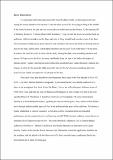Files in this item
Queer kinaesthesia on television
Item metadata
| dc.contributor.author | Shacklock, Zoe Ruth | |
| dc.date.accessioned | 2021-12-11T00:43:35Z | |
| dc.date.available | 2021-12-11T00:43:35Z | |
| dc.date.issued | 2019-12-11 | |
| dc.identifier | 256118108 | |
| dc.identifier | 91c958bf-18ed-4f7a-9370-06570968b75a | |
| dc.identifier | 85079275459 | |
| dc.identifier | 000509387600001 | |
| dc.identifier.citation | Shacklock , Z R 2019 , ' Queer kinaesthesia on television ' , Screen , vol. 60 , no. 4 , pp. 509-526 . https://doi.org/10.1093/screen/hjz037 | en |
| dc.identifier.issn | 0036-9543 | |
| dc.identifier.other | ORCID: /0000-0003-2004-0168/work/76779124 | |
| dc.identifier.uri | https://hdl.handle.net/10023/24498 | |
| dc.description.abstract | The evaluation of queer stories on screen revolves around questions of representation and the politics of visibility. Such frameworks reiterate the conflation between truth and image and the dominance of linear narratives of progress, none of which fit very well with the principles of queer theory. Queerness has always been a question of movement and action more than one of static form, and demands evaluative paradigms that can account for its mobile politics. This essay proposes the concept of ‘queer kinaesthesia’ as both a storytelling language and an evaluative framework, in which queerness is articulated and understood through the moving body. While queer kinaesthesia may be employed across different media, it is particularly at home on television, a medium that is also defined by questions of movement. Through an analysis of recent programmes that use the moving body as a site for the expression of queer identity and queer desire, such as Transparent (Amazon, 2014– ), Sense8 (Netflix, 2015-2018), and American Gods (Starz, 2017– ), the essay argues that kinaesthesia can help us understand both contemporary articulations of queerness and contemporary television. Kinaesthesia highlights the intersections between the queer and the televisual, such as a shared investment in embodied performance, intersubjectivity, and the properties of serial narration. In so doing, it offers a way to approach queer bodies on screen that remains sensitive to their mobile potential, and to reconnect contemporary television to the foundational features of the medium. | |
| dc.format.extent | 18 | |
| dc.format.extent | 511853 | |
| dc.language.iso | eng | |
| dc.relation.ispartof | Screen | en |
| dc.subject | T-NDAS | en |
| dc.subject | BDC | en |
| dc.subject | R2C | en |
| dc.title | Queer kinaesthesia on television | en |
| dc.type | Journal article | en |
| dc.contributor.institution | University of St Andrews. Film Studies | en |
| dc.identifier.doi | https://doi.org/10.1093/screen/hjz037 | |
| dc.description.status | Peer reviewed | en |
| dc.date.embargoedUntil | 2021-12-11 |
This item appears in the following Collection(s)
Items in the St Andrews Research Repository are protected by copyright, with all rights reserved, unless otherwise indicated.

